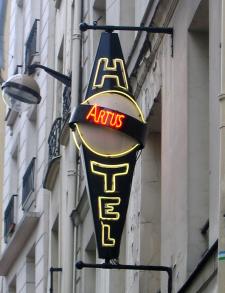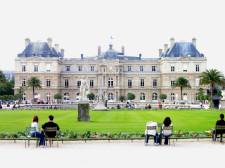|
We had some hard-boiled eggs and the leftover coffee cake for breakfast before getting
on the Autobahn and heading to Paris. We made good time in Germany and Luxembourg and crossed the border into France ahead of schedule.
 We knew how to speak a bit of German, and everyone in Amsterdam seemed to speak English, but we had been so busy with planning the wedding and honeymoon that
we hadn't had time to learn any French. We had brought French language CDs with us, hoping that we would get a chance to listen to them in Europe.
We hadn't yet, so we put them in and spent the ride to France learning how to say a few important French phrases ( like "please", "thank you",
"hello", "goodbye", "Do you understand English?", and "I don't understand French"). Once in France, we stopped at a rest area where we
got gas and a couple of sandwiches. The sandwiches were far better than anything you could get at rest stops in America, and we thought this was validation
of the often heard "You can't get bad food in France". Unfortunately, we later found out that you could, in fact, get horrible food in Paris, although we
had to go all the way to the Charles De Gaulle airport to find some.
Along the highway we saw groups of weird geometric roadside sculptures covered in abstract designs.
This art was great because it was very effective in helping to keep our energy up and attention focused.
We knew how to speak a bit of German, and everyone in Amsterdam seemed to speak English, but we had been so busy with planning the wedding and honeymoon that
we hadn't had time to learn any French. We had brought French language CDs with us, hoping that we would get a chance to listen to them in Europe.
We hadn't yet, so we put them in and spent the ride to France learning how to say a few important French phrases ( like "please", "thank you",
"hello", "goodbye", "Do you understand English?", and "I don't understand French"). Once in France, we stopped at a rest area where we
got gas and a couple of sandwiches. The sandwiches were far better than anything you could get at rest stops in America, and we thought this was validation
of the often heard "You can't get bad food in France". Unfortunately, we later found out that you could, in fact, get horrible food in Paris, although we
had to go all the way to the Charles De Gaulle airport to find some.
Along the highway we saw groups of weird geometric roadside sculptures covered in abstract designs.
This art was great because it was very effective in helping to keep our energy up and attention focused.
So far our drive had gone well, but it soon took a turn for the worse. Our rental agreement stipulated that we would return our car by 3:00 pm,
and although we did not know where the car return was at the airport, we were not worried because we had arrived with 45 minutes to find it.
Unfortunately, returning the car turned out to be more complicated than we had thought. We had brought a book of French road signs, and it implied that "car rental"
signs would say "voigtes" on them. So we had planned to just drive around the airport looking for a sign that said "voigtes" or "Hertz". After about
half an hour of driving in circles and getting increasingly nervous, we stopped at one of the numerous hotels at the airport, figuring that
someone at the front desk would speak English and could tell us where to go. At the first hotel no one spoke English very well, so we got some confusing
directions and set off again. It didn't take long to realize that we must have missed something crucial in the directions, because we weren't seeing
any of the street names we expected. We decided to try another hotel. This time we got lucky and found two people who spoke pretty good English.
They gave us directions and told us we were only about five minutes away from the drop off, so we began to feel like we might still actually make it.
We followed their directions with some confusion and nervousness, but much to our relief we soon began to see signs like "voigtes" and icons of cars and keys.
We eventually ended up at the lowest level of Terminal 2f where we dropped off the car and gave the attendants our Hertz information.
 We took an elevator up to the floor where the taxi pickup was located and found the bathrooms (which turned out to be free). We were staying on the Left Bank,
at the fanciest of the hotels on our honeymoon,
the Artus Hotel, and after an hour long taxi ride, we were deposited in on the sidewalk in front of the hotel.
In the middle of trying to decide who should go in and attempt to say in French "Hello. We have a reservation." (each one arguing
that it should be the other), Sanja walked up and asked us if we were staying at the Artus. After confirming that we were, Sanja took our bags and
showed us our room. At that point, we knew that we had made the right decision in staying at the Artus. True to our quick conjecture, our time at the Artus was very comfortable, and the people
working there were always helpful and friendly.
We took an elevator up to the floor where the taxi pickup was located and found the bathrooms (which turned out to be free). We were staying on the Left Bank,
at the fanciest of the hotels on our honeymoon,
the Artus Hotel, and after an hour long taxi ride, we were deposited in on the sidewalk in front of the hotel.
In the middle of trying to decide who should go in and attempt to say in French "Hello. We have a reservation." (each one arguing
that it should be the other), Sanja walked up and asked us if we were staying at the Artus. After confirming that we were, Sanja took our bags and
showed us our room. At that point, we knew that we had made the right decision in staying at the Artus. True to our quick conjecture, our time at the Artus was very comfortable, and the people
working there were always helpful and friendly.
 After calling Julie's parents and relaxing for a bit, we went out to find some dinner. Our hotel was in the middle of
Rick Steves' Left Bank Walk, so we decided to take that walk while we looked for places to eat. We were amazed by the large numbers of people on the streets.
It turns out that our hotel was in the middle of one of the top nightlife districts in Paris.
We got a sandwich at a nearby
deli and walked the north half of Rick Steves' walk. Along the way we saw the home2s and hangouts of many famous writers and composers, as well as interesting
buildings and statues. One example is the Institut de France,
a French learned society, grouping five académies, the most famous of which is the Académie française.
The Académie française, or French Academy, is the pre-eminent French learned body on matters pertaining to the French language. The Académie was officially established in 1635 by Cardinal Richelieu
and is unlike anything we have in America. It is France's official authority on the usages, vocabulary, and grammar of the French language, although its recommendations carry no legal power.
The Académie publishes the official dictionary of the French language, known as the Dictionnaire de l'Académie française. The Académie has completed eight editions of the dictionary, which have been published in 1694, 1718, 1740, 1762, 1798, 1835, 1878, and 1935. It continues work on the ninth edition.
After calling Julie's parents and relaxing for a bit, we went out to find some dinner. Our hotel was in the middle of
Rick Steves' Left Bank Walk, so we decided to take that walk while we looked for places to eat. We were amazed by the large numbers of people on the streets.
It turns out that our hotel was in the middle of one of the top nightlife districts in Paris.
We got a sandwich at a nearby
deli and walked the north half of Rick Steves' walk. Along the way we saw the home2s and hangouts of many famous writers and composers, as well as interesting
buildings and statues. One example is the Institut de France,
a French learned society, grouping five académies, the most famous of which is the Académie française.
The Académie française, or French Academy, is the pre-eminent French learned body on matters pertaining to the French language. The Académie was officially established in 1635 by Cardinal Richelieu
and is unlike anything we have in America. It is France's official authority on the usages, vocabulary, and grammar of the French language, although its recommendations carry no legal power.
The Académie publishes the official dictionary of the French language, known as the Dictionnaire de l'Académie française. The Académie has completed eight editions of the dictionary, which have been published in 1694, 1718, 1740, 1762, 1798, 1835, 1878, and 1935. It continues work on the ninth edition.
We wanted to go to Versailles the next day because we had heard that on Sundays, the fountains in the gardens would be turned on and accompanied by classical music.
In Rick Steves' Paris book, he said that the lines for Versailles can get ridiculously long (in evidence during our visit),
and we were not looking forward
to getting up early enough to beat the crowds. However, Rick also had another solution: if you purchase a Musee card before arriving at Versailles, you
can skip the general entrance line and go straight to a much shorter line. We had read that you could purchase Musee cards at any subway station, and
since we also needed a carnet of Métro tickets, we decided to visit a Métro stop and try to get both that night. We successfully purchased a carnet, but when we
mentioned the Musee pass, the Métro employee shook his head, and since we couldn't understand what he was telling us, we decided to wait
until the next day to get the pass.
 The Left Bank Walk ended at Luxembourg Gardens, and near the end we saw a
cat walking around a building on a ledge almost 15 feet above the ground. At the north end of the gardens
is the Palais du Luxembourg where the French Senate meets. The palace was originally built for
Marie de' Medici, mother of King Louis XIII of France. During the French Revolution, it was the center of the French Directory and later the first residence of
Napoleon Bonaparte when he was First Consul of France. We walked around Luxemburg Gardens for about an hour and saw people playing chess, walking their dogs, kissing, picnicking, playing tennis, etc., before heading back to our hotel.
The Left Bank Walk ended at Luxembourg Gardens, and near the end we saw a
cat walking around a building on a ledge almost 15 feet above the ground. At the north end of the gardens
is the Palais du Luxembourg where the French Senate meets. The palace was originally built for
Marie de' Medici, mother of King Louis XIII of France. During the French Revolution, it was the center of the French Directory and later the first residence of
Napoleon Bonaparte when he was First Consul of France. We walked around Luxemburg Gardens for about an hour and saw people playing chess, walking their dogs, kissing, picnicking, playing tennis, etc., before heading back to our hotel.
|

